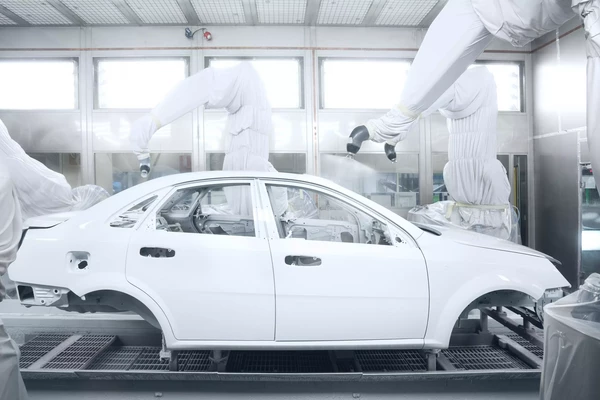Our portfolio for wooden composites
Wood-based materials are produced by shredding the wood and then joining the structural elements. The end product and its properties depend on the source material, size, and dimensions of the wood particles.
Environmental Solutions for Engineered Wood Products
The engineered wood products industry relies on Dürr for regenerative thermal oxidizer (RTO), regenerative catalytic oxidizer (RCO), wet electrostatic precipitator (WESP), and wet scrubber technologies for the effective control of emissions of volatile organic compounds (VOCs), hazardous air pollutants (HAPs), particulate matter (PM), and blue haze from wood dryers and press vents. As an industry leader, we offer a comprehensive suite of advanced air pollution control products. Dürr technologies are used throughout the wood products industry to effectively remove fumes and sticky particulate matter from energy systems, dryers, and press vents. Our systems are designed for minimum maintenance, while allowing the user to meet stringent emissions regulations, including the U.S. EPA Plywood and Composite Wood Products (PCWP) MACT rules.
Oxidizers for VOC Control
Dürr is a leader in providing regenerative thermal oxidizers (RTOs) for VOC/HAP control for products such as OSB, MDF, HDF, SYP, plywood, particleboard, veneer, wood pellets, and other composite wood products, with particular expertise in solving the problems of media plugging and alkali attack associated with wood dryer exhaust.
With thousands of systems installed in process industries worldwide, Dürr has the knowledge to provide the best solution for your specific needs. Our modular, low-maintenance designs use alkali-resistant ceramics and corrosion-resistant construction materials.
Dürr provides rebuild services for upgrading or modifying existing equipment. A typical modification would involve converting a regenerative thermal oxidizer into a regenerative catalytic oxidizer (RCO). A rebuild from an existing RTO to RCO may result in the unit conforming to EPA guidelines, as well as meeting plant-specific permit levels at an operating temperature below the operating set point temperature of the previous RCO. A rebuild can restore environmental performance and reduce operating costs.
Our commitment to the wood products industry is demonstrated by our pilot RTO which is used for testing slip-streams of your process to determine the optimum pre-filtration (cyclone, dry electrostatic precipitator (DESP) or wet electrostatic precipitator (WESP)) and RTO bed design.
With our extensive air handling experience, we can also provide services to reduce fugitive emissions, control process exhaust flow rates, and improve the overall efficiency of your VOC capture systems.
Particulate Control with Electrostatic Precipitator (ESP) Technology
The Dürr wet ESP removes sub-micron particulate matter (including salt residues, tar-pitch, and fibers) and fumes from dryer and energy system gas streams. Our hex-shaped tube design delivers the best combination of removal efficiency, low maintenance, low-pressure drop, and a small footprint. Our venturi scrubber and Sorpt.X SW atomizing scrubber (formerly known as the Turbotak™ scrubber) provide gas stream saturation and high-efficiency (front and back half) particulate removal as a stand-alone system or in front of the WESP.
Dürr WESP upgrades bring facilities with existing air pollution control equipment into compliance. These upgrades eliminate carryover and costly maintenance by utilizing patented and proprietary solutions. Improvements to T/R sets, water treatment systems, gas flow distribution, and mist elimination all help improve performance, reduce operating costs, and protect downstream equipment.
Dürr provides solutions that reduce VOC and particulate emissions for the wood pellet industry, keeping operations in compliance with local regulations.
Environmental Control at Every Process Stage
During the manufacturing of almost all wood-based products, the raw material undergoes similar steps: debarking, chipping, classifying, and drying, followed by post-treatment such as pelletizing, pressing, etc. During most of these steps, volatile organic compounds (VOCs) and/or particulate matter are emitted from the process.
Specifically with respect to wood pellet production, emissions are controlled after the drying process with an environmental system that includes a wet electrostatic precipitator (WESP) and a regenerative thermal oxidizer (RTO). For the post-drying stage (hammer milling, pelletizing, and pellet cooling), a pulse jet fabric filter (baghouse/cyclone), scrubber, and RTO or regenerative catalytic oxidizer (RCO) are deployed.
Dürr offers the following environmental control equipment for the wood pellet market:
- WESP for collection of particulate matter
- RTO for control of VOCs generated during drying
- Wet gas conditioning systems (scrubber) for control of post-drying emissions
- RCO for control of post-drying VOC emissions
Dürr offers a single-source supply, a guarantee and a complete solution to meet the stringent emission regulations of the wood pellet industry.




